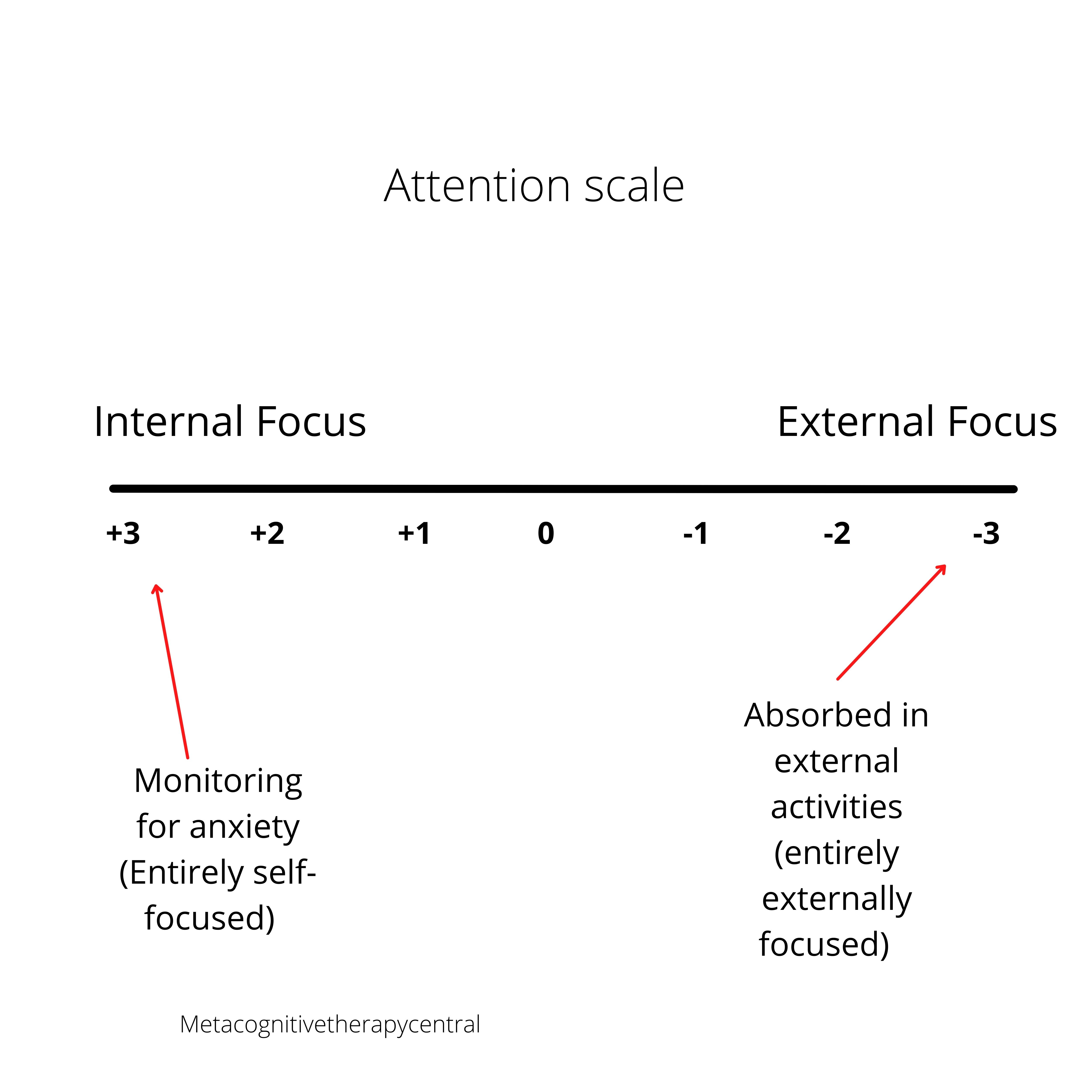
What is the connection between social anxiety and attention?
The common factor in social anxiety disorder is that attention is fixed on internal signs of anxiety and external signs of threat, making someone with social anxiety very self-conscious. However, inflexible attention amplifies the sense of threat, causing more anxiety.
The attention training technique (ATT), developed by Professor Wells, reverses inflexible attention. It teaches socially anxious patients that they can move their attention around flexibly to neutral things in the environment that disprove their sense of threat.
ATT consists of listening to different sounds that are located in different areas in the environment. A daily dose of attention training has proven to reduce self-focused attention in socially anxious people and buffers against performance anxiety (11). However, this is not the only reason that ATT is so effective for social anxiety disorder.
Social anxiety disorder is maintained by fixated attention on oneself and on threats in the environment
What is social anxiety according to Metacognitive therapy?
Socially anxious people turn their attention inward in social situations and monitor themselves closely for how they think they come across (2). They also monitor other people’s reactions to them (rejecting or bored facial expressions) and other things that are perceived as social “threats.” This strategy is also called threat-monitoring.
Self-focused attention is often accompanied by worrying and evaluating one’s social performance.
According to research (4), people with social anxiety have difficulty disengaging their attention from “threatening” situations.
They believe that they cannot control their attention and that they are stuck with noticing their intense anxiety in the situation: “When I am under pressure, I lose my grip on thinking” (3).
This type of thinking is called metacognitive beliefs. According to the founder of Metacognitive therapy, professor Wells, metacognitive beliefs contribute to mental illness, including social anxiety disorder (5).
Examples of metacognitive beliefs in social anxiety disorder are:
Worrying about my social anxiety is uncontrollable
Focusing on an inner image of myself helps me avoid making a bad impression
When I am under pressure, I lose my grip on thinking
As long as socially anxious people believe in these metacognitions, it will be harder for them to stop threat-monitoring, worrying, and ruminating. This is where ATT becomes helpful (3).

When you suffer from social anxiety, you typically fixate on signs of anxiety like blushing, sweating, shaking, sounding stupid or boring, or looking weird in social situations. By fixating on these signs of anxiety, the symptoms will perpetuate and create a vicious anxiety cycle.
How exactly does Attention training technique help social anxiety?
ATT helps you change your attention from being self-focused to becoming externally focused because it alters your metacognitive belief “I can’t control my attention”.
ATT works through paying attention to specific sounds against a background of reference sounds, which enhances the capacity for attention (6). You can read more about ATT and how to train your attention in this post.

People with Social anxiety disorder fixate on their social anxiety by focusing on negative thoughts and symptoms instead of focusing on events outside of themselves. That would be focusing attention on the left side (from 0 to +3) on the attention scale above. The Attention training technique helps to shift attention away from self-consciousness and instead helps:
- Engage less with anxious thoughts and feelings
- Reduce worry about one’s social performance
- Create a shift in focus away from social “threats,” which helps to regulate the feelings of anxiety better
- Teaches the person that he has full control of where he places his attention regardless of how anxious he feels
An example of how flexible attention helps overcome social anxiety is to notice the difference between being very self-conscious and then switching attention and noticing the surroundings instead. When patients can switch attention to other things, they not only notice less anxiety but also believe more in their ability to control attention flexibly. This means that they are less bothered by feeling anxious in social situations because they can choose to pay less attention to their anxiety.
Once they pay less attention to their anxiety, they begin to notice positive things that disconfirm their anxious beliefs (for example, that people are friendly, that they can have interesting conversations, and that they themselves are likable and funny).
ATT supports this process by teaching socially anxious patients that they have full control over their attention regardless of how anxious they feel.

Does Attention training technique work for Social anxiety disorder?
A study by Wells and Nordahl from 2018 (3) proved that MCT effectively reduces social anxiety symptoms without even addressing the content of socially anxious thoughts (e.g., “I look odd,” “I look anxious,” etc..). Instead, the patients’ worrying and self-consciousness were reduced because their metacognitive beliefs changed. This happened with the help of ATT (among other MCT components like, for example, Detached mindfulness). The patients from the study remained recovered 6 months after treatment.
When is attention training technique not helpful?
ATT is developed with the purpose of creating a shift in cognitive style and changing metacognitive beliefs (5). ATT is not supposed to be used as a thought control tool or as a distraction from anxiety. Doing so defeats the purpose of viewing thoughts and feelings as brief and unimportant inner events but instead strengthens the belief that anxiety is harmful and should be avoided.
Therefore, when ATT is used as a distraction from or to calm anxiety, it won’t create long-lasting results because people don’t learn to deal with anxious thoughts in adaptive ways.
Attention training technique (ATT) is part of Metacognitive therapy treatment to help change your metacognitive beliefs. ATT is not a distraction, meditation, or a tool to calm anxiety.
Summary
- Exaggerated and inflexible self-focus maintains social anxiety.
- Excessive attention to negative thoughts and feelings prevents the mind from regulating itself, which sustains anxious feelings and intensifies a sense of social threat.
- Attention training technique can help reverse inflexible self-focus and strengthen one’s control over attention.
- Attention training technique is used as a part of Metacognitive therapy to change metacognitive beliefs.

What you should do if you suffer from social anxiety
(This advice does not substitute for professional therapy. Always consult an MCT-I certified therapist if you suffer from mental illness).
- Reduce worry before going to a social event and reduce rumination after. If you must, postpone worrying to a restricted 15-minute window only.
- Practice focusing away from yourself during social situations (away from your thoughts, feelings, and symptoms). Instead, focus on the content of the conversation and actually look and listen to the person you are talking to. This will help you strengthen flexible control over your attention.
Here is a quote to help you navigate social situations better:
“Focus on the other person. Don’t think about yourself or how you’re coming across. Just be your natural self and respond to whatever the other person says without thinking about that. Say whatever comes to mind. Absorb yourself in the conversation, focusing on the other person. As if it is the most interesting conversation you have ever had.”
Leigh et al, 2021 (8)
References
- Photo by Nick Fewings – Unsplash
- Clark, D. M., & Wells, A. (1995). A cognitive model of social phobia. In R. G. Heimberg, M. R. Liebowitz, D. A. Hope, & F. R. Schneier (Eds.), Social phobia: Diagnosis, assessment, and treatment (pp. 69–93). The Guilford Press.
- Nordahl H., Wells A. (2018) Metacognitive Therapy for Social Anxiety Disorder: An A–B Replication Series Across Social Anxiety Subtypes. Frontiers in Psychology, Volume 9. https://www.frontiersin.org/articles/10.3389/fpsyg.2018.00540
- Amir N, Beard C, Taylor CT, Klumpp H, Elias J, Burns M, Chen X. Attention training in individuals with generalized social phobia: A randomized controlled trial. J Consult Clin Psychol. 2009 Oct;77(5):961-973. doi: 10.1037/a0016685. PMID: 19803575; PMCID: PMC2796508.
- Wells A (2009). Metacognitive Therapy for Anxiety and Depression: New York: Guilford Press
- Bajo VM, King AJ. Focusing attention on sound. Nat Neurosci. 2010 Aug;13(8):913-4. doi: 10.1038/nn0810-913. PMID: 20661266; PMCID: PMC4353843.
- Photo by Brooke Cagle – Unsplash
- Leigh E, Chiu K, Clark DM (2021) Self-focuse attention and safety behaviours maintain social anxiety in adolescents: An experimental study. PLoS ONE 16(2): e0247703. https://doi.org/10.1371/journal.pone.0247703
- Photo by Elijah Hiett – Unsplash
- Photo by Day Pham – Unsplash
- Jones, Christopher R., Russell H. Fazio and Michael W Vasey. “Attentional Control Buffers the Effect of Public-Speaking Anxiety on Performance.” Social Psychological and Personality Science3 (2012): 556 – 561.



